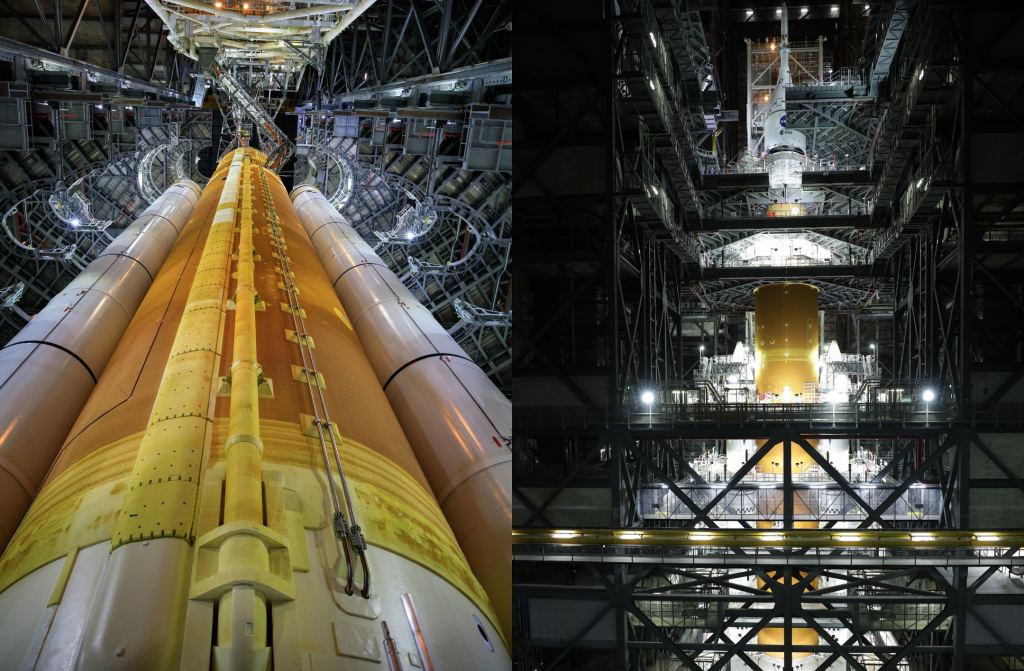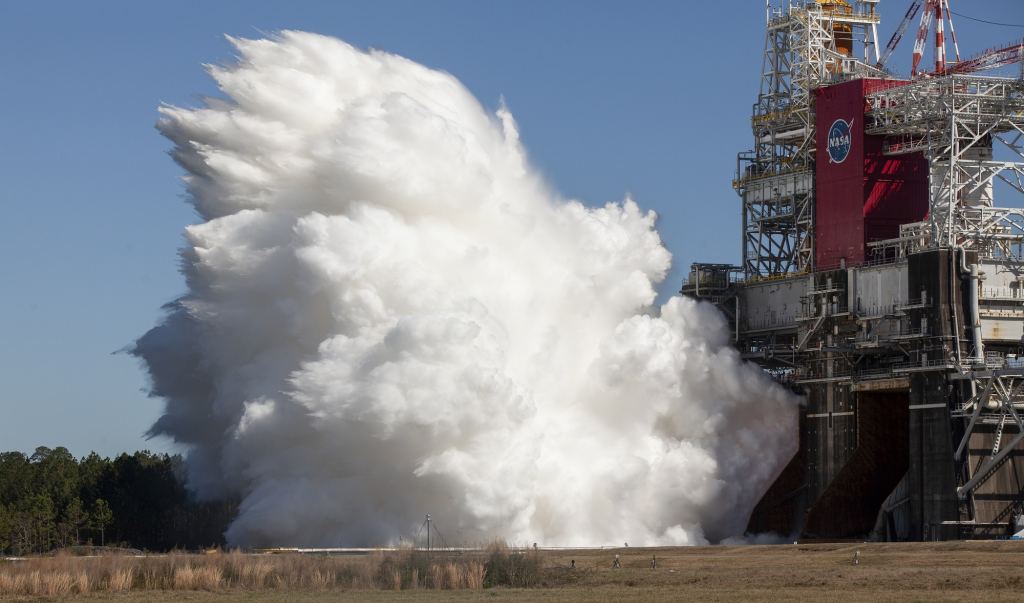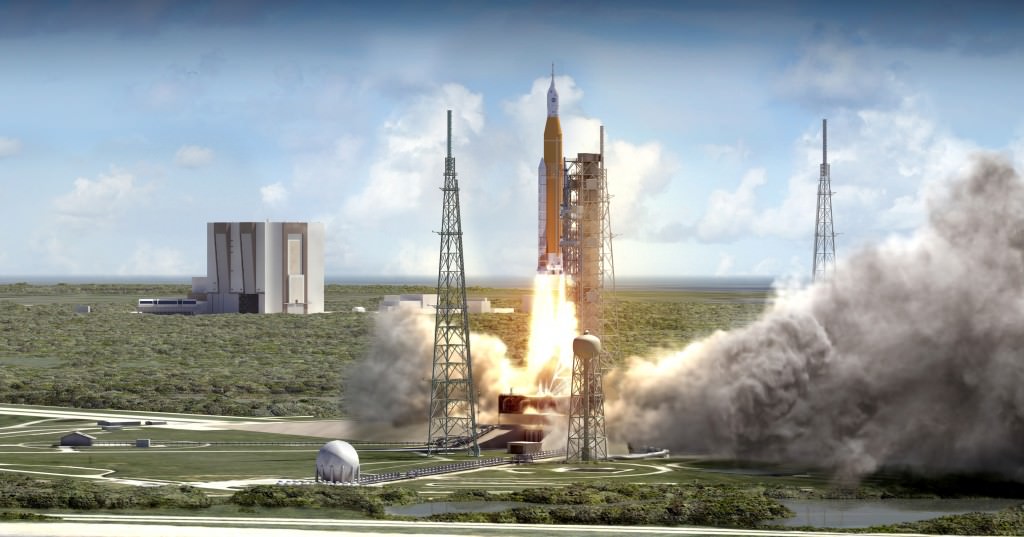Since 2004, NASA has been working on the launch system that will send astronauts to the Moon for the first time since the Apollo Era. These efforts bore fruit in 2011 with the proposed Space Launch System (SLS), the heaviest and most powerful rocket since the Saturn V. Paired with the Orion spacecraft, this vehicle will be the workhorse of a new space architecture that would establish a program of sustained lunar exploration and even crewed missions to Mars.
Due to repeated delays, cost overruns, and the expedited timeframe for Project Artemis, there have been serious doubts that the SLS will be ready in time. Luckily, ground crews and engineers at NASA’s Launch Control Center (LCC) – part of the Kennedy Space Center in Florida – recently finished stacking the Artemis I mission. The vehicle is now in the final phase of preparations for this uncrewed circumlunar flight in February 2022.
The fully-stacked Artemis I rocket includes the SLS Core Stage, the expendable solid rocket boosters, the Orion Multi-Purpose Crew Vehicle (MPCV), and the European Service Module (ESM) – the European Space Agency’s (ESA) contribution to the Artemis Program. Now that these systems are all integrated, they will undergo a series of test campaigns that will evaluate them as a fully integrated system for the first time.
 Space Launch System Program (SLS) inside the Vehicle Assembly Building at NASA’s Kennedy Space Center in Florida. Credit: NASA/Frank Michaux
Space Launch System Program (SLS) inside the Vehicle Assembly Building at NASA’s Kennedy Space Center in Florida. Credit: NASA/Frank Michaux
Each of these tests will build upon the last, culminating in a simulation on the launch pad that will serve as a “dress rehearsal” for launch. As Mike Bolger, the Exploration Ground Systems program manager at the LCC, said in a recent NASA press release:
“It’s hard to put into words what this milestone means, not only to us here at Exploration Ground Systems, but to all the incredibly talented people who have worked so hard to help us get to this point. Our team has demonstrated tremendous dedication preparing for the launch of Artemis I. While there is still work to be done to get to launch, with continued integrated tests and Wet Dress Rehearsal, seeing the fully stacked SLS is certainly a reward for all of us.”
Altogether, four testing campaigns will take place before the “Wet Dress” Rehearsal, where the rocket is fully loaded with cryogenic propellant, and a full pre-launch sequence is conducted. These tests include:
Interface Verification: This campaign will take place in the firing room at the LCC, where the crews will verify the core stage engines, booster thrust control, and the Interim Cryogenic Propulsion Stage (ICPS). The ground crews will also check the functionality and interoperability of the interfaces between the core stage, boosters, and ground systems. A final integrated test of all the wire harnesses throughout the rocket and spacecraft will verify their ability to talk to each other and ground systems.
 The core stage for the first flight of NASA’s Space Launch System rocket is seen in the B-2 Test Stand during a second hot fire test, Thursday, March 18th, 2021, at NASA’s Stennis Space Center. Credit: NASA/Robert Markowitz
The core stage for the first flight of NASA’s Space Launch System rocket is seen in the B-2 Test Stand during a second hot fire test, Thursday, March 18th, 2021, at NASA’s Stennis Space Center. Credit: NASA/Robert Markowitz
Program Specific Engineering: Following the interface verification test, the crews will perform multiple checks for the core stage and booster systems (like the booster thrust control test) from the VAB. Afterward, the ground crews will conduct an engineering test of the fully integrated rocket during the visit to Launch Complex 39B for the wet dress rehearsal.
End-to-End Communications: Next, the crews will conduct an integrated test of radio frequencies using a radio frequency antenna in the VAB, another near the pad, and another that relies on the Tracking Data Relay Satellite (TDRS) and the Deep Space Network (DSN). These antennas are used by mission control to communicate with the SLS, ICPS, and Orion during launch, in orbit, and locations in deep-space.
Countdown Sequencing: The next step will consist of a simulated launch countdown inside the VAB to demonstrate the ground launch software and ground launch sequencer. This latter system hands over the countdown to an automated launch sequencer 30 seconds before launch. While the vehicle sits on the pad, the teams will configure the rocket for launch, run the sequencer to a predefined point in the countdown, and test the responses from the rocket and spacecraft.
For the Wet Dress Rehearsal, which will take place several weeks before the launch, the rocket will be transferred to the pad at Launch Complex 39B using the crawler-transporter. Once there, the crews will practice loading and unloading the rocket with cryogenic propellant and running mock countdowns. This will allow them to practice launch procedures and a launch scrub (followed by detanking).
 Artist’s impression of NASA’s Space Launch System (SLS) blasting off from launchpad 39B at the Kennedy Space Center. Credit: NASA/MSFC
Artist’s impression of NASA’s Space Launch System (SLS) blasting off from launchpad 39B at the Kennedy Space Center. Credit: NASA/MSFC
Before and after the “Wet Dress” takes place, the ground teams will conduct the two tests of the flight termination system as well as a final round of inspections and checkouts inside the VAB. The mission operations team will continue to run launch simulations until February 2022 to remain sharp and ensure that they are ready for any scenario that arises on launch day. NASA will set a specific launch date once the Wet Dress Rehearsal is successfully concluded.
As the first mission of the Artemis Program, Artemis I will validate the SLS, the Orion spacecraft, the ESM, and other spaceflight elements for the crewed missions that will follow. Artemis II, which is currently scheduled to launch in September 2023, will see four astronauts conduct a lunar flyby without landing on the surface. Artemis III, which will be humanity’s long-awaited return to the lunar surface, is still officially scheduled for September 2024.
NASA expects this to be delayed due to issues with the Human Landing System (HLS), a necessary mission element ever since the previous administration expedited the program’s timeline. However, this could be a good thing, as the decision to land astronauts on the surface by 2024 has forced all kinds of difficult decisions on NASA’s mission planners, engineers, and administrators.
Among them is how the Lunar Gateway was deprioritized, and the task of launching its core elements was farmed out to SpaceX. There were even some indications that NASA was prepared to contract the launch services for the Artemis III mission. A little breathing room at this point could be just what the agency needs to get everything on track. With all the work that went into building the most powerful rocket since the Saturn V, it would be a shame not to use it!
In the meantime, check out this time-lapse video of the Artemis I rocket being stacked in the Vehicle Assembly Building at NASA’s Kennedy Space Center, courtesy of the European Space Agency:

